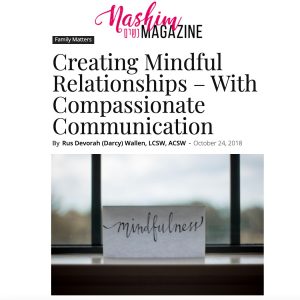It may simply be that he has a small piece of fluff in his ear.” – Winnie the Pooh (A. A. Milne)
“Between stimulus and response there is a space. In that space is our power to choose our response.
In our response lies our growth and our freedom.” – Viktor E. Frankl
“In times of stress, the best thing we can do for each other is to listen with our ears and our hearts
and to be assured that our questions are just as important as our answers.” – Mr. (Fred) Rogers
How can we create more mindful relationships? How can we be more attentive and mindful in general? Ironically, being mindful is actually the opposite of having a mind that is full. To be a good communicator, one needs to be receptive, open to receive what the other is trying to convey. If my mind is “full”, I give little room for another person’s thoughts, ideas, or opinions. So what does having “mindful communication” or a “mindful relationship” mean?
The Merriam-Webster definition of “mindful” is: “bearing in mind: AWARE…2: inclined to be aware…” So following the dictionary, mindful relationships and mindful communication are when we bear the other party in mind and incline ourselves toward awareness of them. In today’s society, most of us (even if we are “digital immigrants”) are distracted by technology. Just owning a smart phone puts us at risk for being less mindful and aware in general. Couple that with all of the ringing and dinging and alarms. The phone pulls us away from being present. When it signals us, it’s compelling. We jump. Many people using their devices don’t even look up to see where they’re going, what they are missing, or who is in front of them while they are texting!
With this backdrop, how can we possibly enhance our communication skills to become more present, sensitive, and aware? In their book, Words Can Change Your Brain, Dr. Andrew Newberg and Mark Robert Waldman explain the book’s title in detail and the best ways to communicate with others. They give 12 strategies of “Compassionate Communication”. Here, I will touch on some of their strategies, augmenting them with a few of my own. Even though their strategies make sense— and seem obvious—when we’re in the midst of “passionate communication”, it is very difficult to naturally have “compassionate communication”. The capacity for these qualities is developed, learned and practiced. In their book, the authors recommend using these strategies, one after the next, in an exercise. Here, we will just summarize them and discuss what we can do to enhance our own compassionate communication skills with them.
Newberg and Waldman’s 12 Strategies of Compassionate Communication from Words Can Change Your Brain: 12 Conversation Strategies to Build Trust, Resolve Conflict, and Increase Intimacy:
1. Relax
2. Stay present
3. Silence inner voices
4. Be positive
5. Focus on inner values
6. Recall a pleasant memory
7. Maintain eye contact
8. Be complimentary and express appreciation
9. Speak with warmth in your voice
10. Speak slowly
11. Speak briefly
12. Listen carefully
Relax | Stay Present | Silence Inner Voices | Recall a Pleasant Memory
I believe this is where all of mindful communication begins. To maintain healthy and compassionate communication, we need to be relaxed. Neuroscience explains how stress can actually diminish our ability to attend, be present, and understand what is being communicated. When our stress response is triggered, the amygdala is activated in the brain. This is the emotional, reactive brain. The intelligent, mature forebrain—the prefrontal cortex (PFC)—goes offline. It’s no wonder why we say insensitive, hurtful, or stupid things when we are under pressure. In my psychotherapy practice, I teach my clients breathing activities to de-escalate the stress response (“fight or flight, freeze or fawn”) and to enhance the parasympathetic response (“rest and digest”). As the person calms down, the heartbeat slows, respiration is less labored, bodily tensions ease, etc. Once calmed down, one is able to listen or speak with clarity and intelligence. (My signature relaxation breathing technique is called, The Breathing Contest™, and it, along with a guided imagery audio, can be ordered in my GIFTPAK—see link in my bio.)
If you have an important discussion, or know you will have an intense conversation that will trigger you, consider practicing a slow breathing technique or listening to a guided imagery audio beforehand to prepare yourself. Additionally, if you can recall a pleasant memory which evokes all of your senses, you will calm down quickly and be “available” to speak and listen. In the background, dedicate a short, daily practice of doing a simple meditation that can take as little as a minute or two. This helps you gain the mental control of “presence of mind”. The skill you are developing is coming back to whatever you need to give attention to. Proper breathing practices can help you train yourself in the ability to focus on your breath and gain the ease of shifting off of a thought or topic that is not your breath. This helps silence our inner voices. The more a person regularly practices these relaxation and meditation techniques, the calmer she will be and the better her ability to stay in the present moment.
Be Positive | Focus on Inner Values | Maintain Eye Contact
We all want positive attention. We are deprived of real face-to-face attention these days with all the texting, emailing, emoji’ing. When someone wants us to listen to them, they need and deserve our full attention. That means we need to look the person in the eye (not the “I”, as in iPhone). Communication is bidirectional. One person doesn’t have all the responsibility or reap all the benefits. Talking at someone is a one-way street, and so is not paying attention. If we can focus on our most important values, and be in a positive state of mind, this enhances the communication process. Our brain has “mirror neurons” which cause us to mirror and echo what others nearby are doing. When someone is upbeat and positive, it affects others. I find it fascinating that current neuroscience trends have been known by the Torah for thousands of years. Science is finally catching up with the Torah’s sophistication!
“Just like water reflects back the face, similarly the heart of a person affects another person’s heart.” – Proverbs 27:19
“Greet each person with a kindly countenance.” – Ethics of the Fathers, 1:15
About 15 years ago, I did an experiment in a neighborhood in New York City. As I walked up the street, I smiled and had my head up, ready to look anyone in the eye. At the beginning, I could see people averting their eyes (I guess New Yorkers are a bit paranoid). As I became more comfortable and natural doing it, I was able to look not just smilingly, but softly, into the faces of those who passed me. Some people, even if they looked somber to begin with, were eventually smiling. Some immediately acknowledged me and received it well. But even if they were initially hesitant, almost everyone smiled back at me when I looked them in the eyes. Imagine the multitudes of people who can be positively affected by mirror neurons and smiling if everyone knew this “secret”? Regarding the art of smiling, Dr. Newberg has done extensive MRI studies on various activities and their effect on the brain. He says that smiling is the 8th best thing you can do for your brain!* It takes no time, money, or effort to perform, and you get big bang for your buck.
Speak With Warmth in Your Voice | Speak Slowly | Speak Briefly | Listen Carefully
When you speak calmly and slowly, with warmth in your voice, you are settling the other person’s nervous system! Remember the mirror neurons? This allows the other person to be more calm and present in the conversation. By speaking slowly and briefly, we give the person time to absorb what we’re saying. According to Mark Waldman, a neuroscience coach, we should try to speak in sentences of less than ten words, and pause between them. When we listen carefully to the other person, we show them our complete attention, validation, and care. As we said above, everyone appreciates real attention.
I mentioned previously how mindful communication (which leads to mindful relationships) must begin with the first grouping of strategies. If one is relaxed, present, and able to silence the inner voices, all the other strategies will fall into place. We need the calm and present forebrain (PFC) to accomplish the others. By practicing relaxation and meditation techniques, you will be able to create a positive atmosphere when communicating.
Although there are volumes that can be discussed about this topic, I believe that by practicing even some of the skills mentioned here, we can have much better communication with our friends, family, and coworkers. Mindful and compassionate communication is the crowning glory of humankind. We are all aware how speech can be used for the extreme good, or for its opposite. As we see in the Yom Kippur confessions, sins of speech abound!
On the other hand, we see a fascinating thing in the hierarchy of the strata of creation. The Torah calls the human person, a “m’daber – a speaker” (not a person, a man, a human). The four strata are: domeim – (silent) mineral, tzome’ach – (growing) vegetative, chai – (living) animal and m’daber – (speaker) human. There are dozens of words in the holy tongue that can signify a person. Why is the human being called ‘speaker’ in this system? It is to show that speech is the crowning glory of the human being. With speech, one can teach, inspire, calm, entertain, convey emotions, pray, share, love, encourage another, and so much more! No other species is given this special gift of the gab. When harnessed for the good, with skills and strategies, one can develop the “space” that Dr. Viktor Frankl describes: “Between stimulus and response there is a space. In that space is our power to choose our response. In our response lies our growth and our freedom.”
May we appreciate the power with which we have been endowed, and may we use it compassionately toward ourselves, our families, and our friends!
* Here are the 8 Great Things you can do for your brain from How God Changes Your Brain by Newberg and Waldman: 8) Smile 7) Stay Intellectually Active 6) Consciously Relax 5) Yawn 4) Meditate 3) Do Aerobic Exercise 2) Dialogue with Others 1) Have Faith in G-d!



